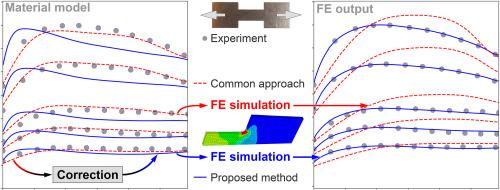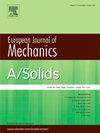Accurate determination of uniaxial flow behaviour of superplastic materials
IF 4.4
2区 工程技术
Q1 MECHANICS
引用次数: 0
Abstract
The design of superplastic forming technologies requires accurate description of material flow behaviour. Furthermore, as the flow curves reflect the deformation mechanisms and microstructure evolution of a material, their accurate determination is an important aspect of material science. The standard experimental method for determining superplastic flow curves is the tensile test, which encounters a significant challenge known as a gripping problem. In superplastic forming conditions, utilizing an extensometer proves difficult, leading to strain determination solely based on crosshead positions. This oversight neglects the non-uniform deformation of a specimen and the material flow occurring in the gripping region. This study presents a novel technique aimed at addressing this issue during the analysis of tensile test data, thereby establishing a reliable material model. The proposed technique was applied to construct the flow behaviour model of an aluminium alloy of the Al–Mg–Fe–Ni system at 460 °C based on the results of tensile tests in the strain rate range of . The material model was developed using the hyperbolic sine equation with strain-dependent parameters, employing sequential polynomial approximation to reduce the number of utilized coefficients. This model was then used in simulations of tensile tests with various geometries to validate its accuracy.

超塑性材料单轴流动特性的精确测定
超塑性成形技术的设计需要准确描述材料的流动行为。此外,由于流动曲线反映了材料的变形机制和微观结构演变,因此准确测定流动曲线是材料科学的一个重要方面。确定超塑性流动曲线的标准实验方法是拉伸试验,这种方法会遇到一个被称为 "夹持问题 "的重大挑战。在超塑性成形条件下,使用拉伸计很困难,导致应变测定只能基于十字头位置。这种疏忽忽略了试样的非均匀变形和夹持区域的材料流动。本研究提出了一种新技术,旨在解决拉伸测试数据分析过程中的这一问题,从而建立可靠的材料模型。根据应变率范围为 0.002-0.06s-1 的拉伸试验结果,提出的技术被用于构建铝-镁-铁-镍系铝合金在 460 °C 下的流动行为模型。该材料模型是利用双曲正弦方程和应变相关参数建立的,采用了序列多项式近似方法来减少使用系数的数量。该模型随后用于各种几何形状的拉伸试验模拟,以验证其准确性。
本文章由计算机程序翻译,如有差异,请以英文原文为准。
求助全文
约1分钟内获得全文
求助全文
来源期刊
CiteScore
7.00
自引率
7.30%
发文量
275
审稿时长
48 days
期刊介绍:
The European Journal of Mechanics endash; A/Solids continues to publish articles in English in all areas of Solid Mechanics from the physical and mathematical basis to materials engineering, technological applications and methods of modern computational mechanics, both pure and applied research.

 求助内容:
求助内容: 应助结果提醒方式:
应助结果提醒方式:


